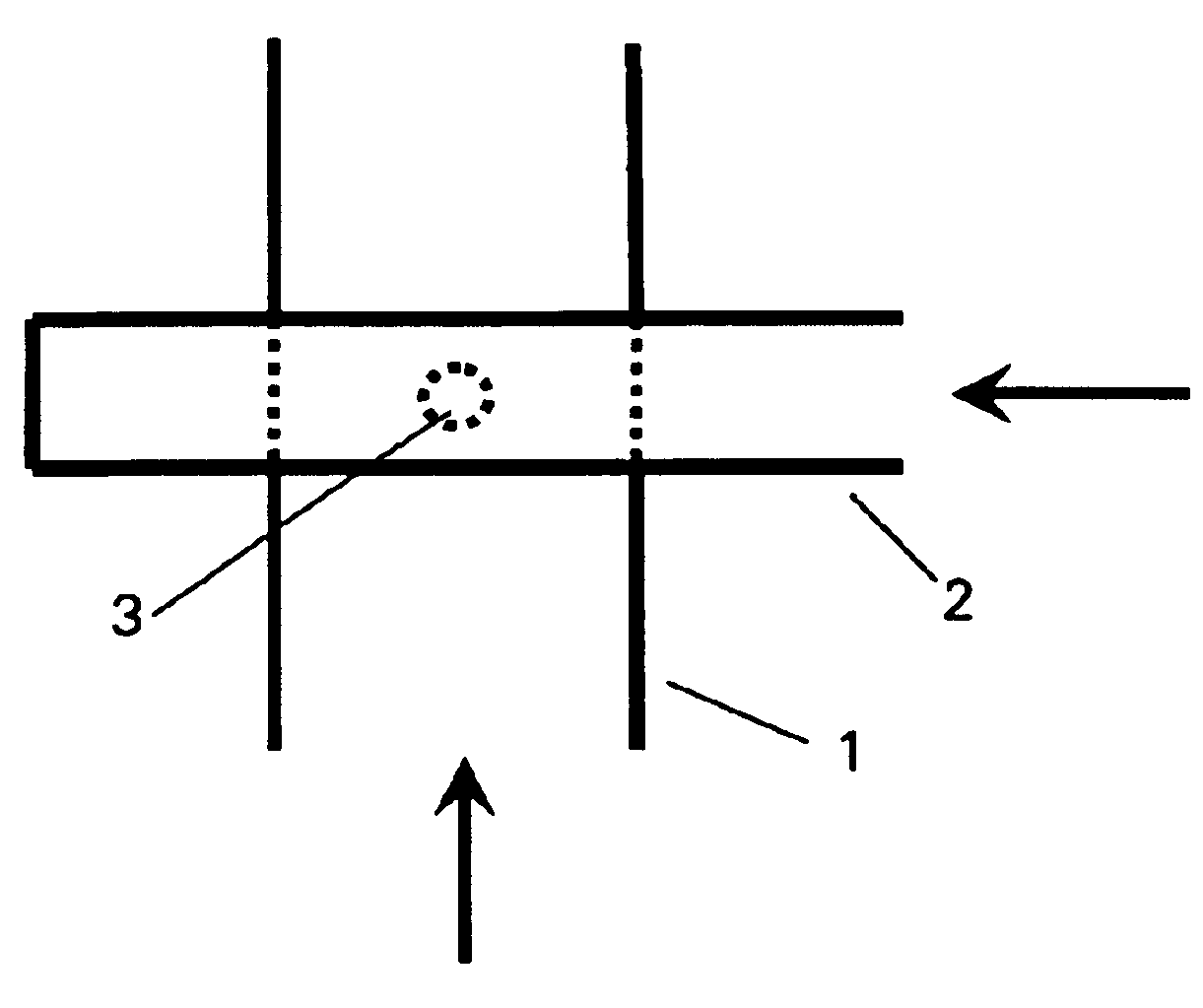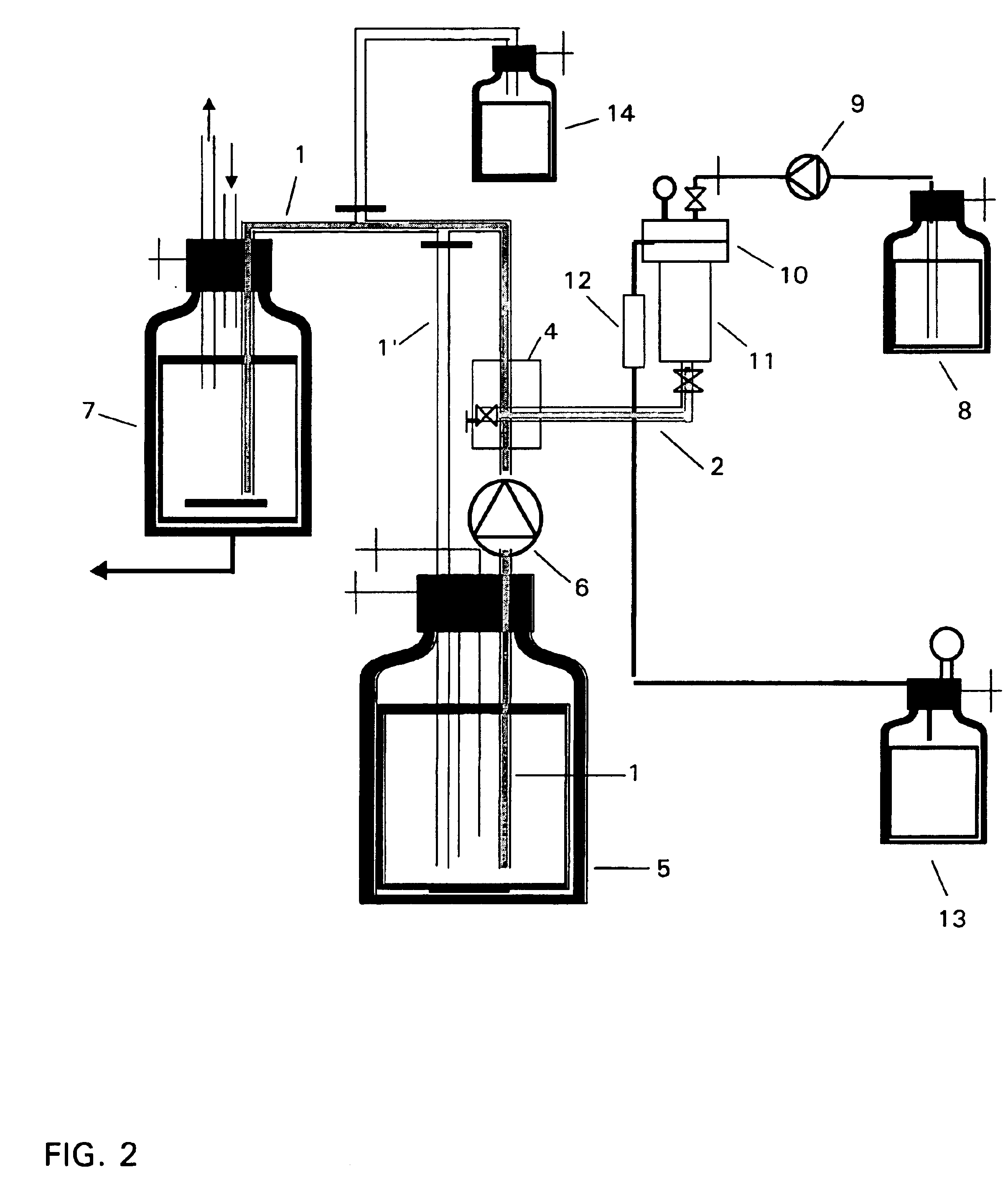Method and device for producing lipid vesicles
a technology of lipid vesicles and lipids, which is applied in the field of vesicular preparations, can solve the problems of large product loss, change of stability, high pressure and temperature, etc., and achieve the effect of easy and rapid integration
- Summary
- Abstract
- Description
- Claims
- Application Information
AI Technical Summary
Benefits of technology
Problems solved by technology
Method used
Image
Examples
example 2
Comparison of One-Stage Process (Without Recirculation) and Process with Recirculation
The procedure is that according to Example 1, and any differences are shown in Table 1 below. The experimental arrangement for the recirculation process corresponds to the apparatus which is shown schematically in FIG. 3, and that for the one-stage process corresponds to the apparatus according to FIG. 2. The results are shown in Table 1 and FIG. 4.
TABLE 1Comparison of the vesicle size distribution in the one-stage andrecirculating processPercent [%] of all vesicles inVesicle size rangePR* withPR* without recirculation[nm]recirculation(“one-stage”)0 00 0-100610.48100-20064.1160.78200-35020.8322.64350-5007.915.09500-6501.451.12650-8000.140.38800- 0.180.3Lipid phaseLipid10 μmol of DPPC / 1 ml of polar phaseHole250 μmMeteringPressure superposition with nitrogenMetering pressure1.6bar1.5barFlow rate 75 ml / minPolar phaseSolvent PBSTubeSilicone; 6 mm internal diameterFlow rat...
example 3
Influence of the Metering Pressure of the Lipid-containing Phase on Size and Size Distribution of the Lipid Vesicles
Example 1 is repeated without rh-SOD and with the following modifications: In contrast to Example 1, the polar phase is recirculated. The lipid phase contains altogether 1470 mg of DPPC, corresponding to 20 μmol of DPPC (molecular weight of DPPC=734) per 1 ml of polar phase. Metering pressure of 1.2 and 2.4 bar and 2.5 and 4.5 bar for the lipid-containing phase are compared with one another.
TABLE 2Comparison of the vesicle size distribution of liposome batches(20 μmol of lipid / ml of polar phase) with different metering pressuresVesicle size rangePercent [%] of all vesicles at[nm] 1.2 bar 2.4 bar0 00 0-1002.894.95100-20026.847200-35019.7321.03350-50021.2115.19500-65011.866.55650-8008.263.14800- 10.13.16
In this and all other experiments described herein, the vesicle sizes were determined by means of flow cytometry, adapted according ...
example 4
Influence of the Metering Pressure of the Lipid-containing Phase on Size and Size Distribution of the Lipid Vesicles
Example 1 is repeated without rh-SOD and with the following modifications: In contrast to Example 1, the polar phase is recirculated. Three experimental batches of the same lipid concentration are compared with one another, metering pressures of 0.3, 1.2 and 2.0 bar being tested for the feeding of the lipid-containing phase into the polar phase. The polar phase contains in each case a constant 200 ml of PBS, the lipid phase contains in each case 1470 mg of DPPC in 15 ml of ethanol (92% by volume), corresponding to 10 μmol of DPPC (molecular weight of DPPC=734) per 1 ml of polar phase. In this example, the lipid-containing phase is transported with the aid of a gear pump of the type Gather P 15133. The results are shown in Table 3 and in FIG. 6.
TABLE 3Size comparison of the vesicles from liposome batches (10 μmolof lipid / ml of polar phase) produced using metering pressu...
PUM
| Property | Measurement | Unit |
|---|---|---|
| internal diameter | aaaaa | aaaaa |
| pressure | aaaaa | aaaaa |
| diameter | aaaaa | aaaaa |
Abstract
Description
Claims
Application Information
 Login to View More
Login to View More - R&D
- Intellectual Property
- Life Sciences
- Materials
- Tech Scout
- Unparalleled Data Quality
- Higher Quality Content
- 60% Fewer Hallucinations
Browse by: Latest US Patents, China's latest patents, Technical Efficacy Thesaurus, Application Domain, Technology Topic, Popular Technical Reports.
© 2025 PatSnap. All rights reserved.Legal|Privacy policy|Modern Slavery Act Transparency Statement|Sitemap|About US| Contact US: help@patsnap.com



